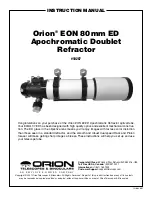
`
3
Figure 1-1 Shown PowerSeeker 76AZ (PowerSeeker 114AZ similar)
1.
Finderscope (PS 114AZ is different – see below)
7.
Azimuth Lock
2.
Eyepiece
8.
Accessory Tray
3.
Collimation Adjustment Screws (in rear)
9.
Tripod
4.
Telescope Optical Tube
10.
Alt-Az Mount
5.
Primary Mirror (inside rear cell)
11.
Altitude Lock
6.
Altitude Slow Motion Rod Assembly
12.
Focus Knob
ASSEMBLY
This section covers the assembly instructions for your PowerSeeker telescope. Your telescope should be set up indoor the first time so that it is easy to identify the
various parts and familiarize yourself with the correct assembly procedure before attempting it outdoor.
Your PowerSeeker comes in one box. The pieces in the box are – optical tube, altazimuth mount, and “The SkyX” CD-ROM, eyepieces 1.25” –
25mm/20mm/12.5mm/8mm/4mm, Barlow lens 1.25” 3x.
S
S
e
e
t
t
t
t
i
i
n
n
g
g
u
u
p
p
t
t
h
h
e
e
T
T
r
r
i
i
p
p
o
o
d
d
1.
Remove the tripod from the box (Figure 2-1). The tripod comes preassembled so that the set up is very easy.
2.
Stand the tripod upright and pull the tripod legs apart until each leg is fully extended and then push down slightly on the tripod leg brace (Figure 2-2). The
very top of the tripod is called the tripod head (AZ mount).
3.
Next, we will install the tripod accessory tray (Figure 2-3) onto the tripod leg brace (center of Figure 2-2).
4.
On the bottom of the tripod tray is a screw attached to the center. The screw attaches into a threaded hole in the center of the tripod leg brace by turning it
clockwise - note: pull up slightly on the tripod leg brace to make it easy to attach. Continue turning the tray until hand tight – don’t over tighten the tray.
Figure 2-1
Figure 2-2
Figure 2-3
5.
The tripod is now completely assembled (Figure 2-4).
6.
You can extend the tripod legs to the height you desire. At the lowest level the height is about 27” (69cm) and extends to about 47” (119cm). You unlock
the tripod leg lock knobs at the bottom of each leg (Figure 2-5) by turning them counterclockwise and pull the legs out to the height you want & then lock
the knobs securely. A fully extended tripod looks similar to the image in Figure 2-6.
7.
The tripod will be the most rigid and stable at the lower heights.
1
2
4
3 & 5
6
7
8
9
11
10
12
































